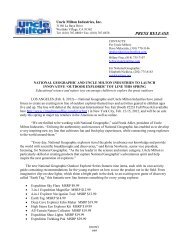PAINTED LADY BUTTERFLY - Uncle Milton
PAINTED LADY BUTTERFLY - Uncle Milton
PAINTED LADY BUTTERFLY - Uncle Milton
Create successful ePaper yourself
Turn your PDF publications into a flip-book with our unique Google optimized e-Paper software.
<strong>PAINTED</strong> <strong>LADY</strong> <strong>BUTTERFLY</strong><br />
Vanessa cardui<br />
The Painted Lady buttery is one of the most common of all<br />
butteries. It, like other insects, has three pairs of legs, but<br />
the front pair is reduced in size. The front legs are too short<br />
to be useful for walking and are kept folded against the<br />
chest. Painted Ladies have hairy front legs and hence are<br />
grouped with other brush-footed butteries.<br />
The wingspan is 4.5 to 6 cm (1 ¾ to 2 ¼ in). The tops of the<br />
wings are white, orange, brown, and black. The undersides<br />
also have tan, blue, and purple. The tips of the forewings are<br />
black with white spots and smooth (not ragged) edges. The<br />
Painted Lady’s natural habitat is open woods, meadows, and<br />
deserts all over the United States and Mexico and much of<br />
Canada.
Painted Lady caterpillars feed on such plants as ddleneck, nettle and<br />
hollyhock; the adults feed on nectar from any ower. An adult sucks tout<br />
the ower nectar by means of a long proboscis. Taste receptors on the<br />
second two pairs of legs enable the buttery to taste sweet liquids with<br />
its feet. Contact of these organs with the petals of a ower sets o a<br />
reex that uncoils the long, exible proboscis that can be worked into<br />
the smallest opening to reach the ower nectar. In feeding, these<br />
butteries pollinate and cross-pollinate a vast number of plants.<br />
Egg Caterpillar<br />
Butterfly<br />
Pupa<br />
chrysalis<br />
Metamorphosis of a buttery has four distinct developmental stages:<br />
egg, larva (caterpillar), pupa (chrysalis), and adult. At room temperature<br />
the Painted Lady buttery remains in the egg stage for 4 days, in the<br />
larval stage for 12 to 18 days, and in the pupal stage for about 8 days.<br />
The adults mate and begin laying eggs within 4 days after they emerge
from the pupal stage.<br />
At normal room temperature, growth of the caterpillars will be rather fast.<br />
From 7 to 11 days after you receive them, the caterpillars will have<br />
nished their growth and will have changed to the pupal stage<br />
(chrysalids). Buttery larvae form chrysalises, characterized by a hard<br />
casing surrounding the pupae. Buttery larvae do not spin cocoons;<br />
cocoons are protective casings built by moth larvae.<br />
After the adult emerges from the chrysalis, a red liquid, called meconium,<br />
is sometimes forced from the tail of the buttery. It is left over from wing<br />
formation, along with unneeded tissues of the caterpillar. The buttery<br />
will pump uid into its wings to help them unfold. The wings will dry and<br />
harden within 24 hours.<br />
CARE AND MAINTENANCE<br />
You will receive several buttery larvae and a dark layer<br />
of food in a plastic cup with some lter paper on top.<br />
Open the container and observe each larva to be sure<br />
they arrived alive. Put the lter paper and the lid back<br />
on the cup securely and keep the lid on until the<br />
chrysalis has formed.<br />
The caterpillars can take a fairly wide range of<br />
temperatures. Growth stops at or below about 50º F<br />
and at or above 110º F. Optimum temperature is about<br />
85º F. Keep the caterpillars out of direct sun, and don’t<br />
let them freeze.<br />
85 º<br />
Feeding the larvae is simple; just keep them on the prepared food in the<br />
cup which they were shipped. Put the container into the Buttery House<br />
keeping the lid on. They will spend most of their time eating, inside the<br />
small container.<br />
The larvae will feed and grow for 7 to 10 days. Then they will crawl to the<br />
top of the container and hang down. After about a day the skin splits<br />
down the back; underneath are the chrysalises. They will soon harden<br />
and change to a golden color. Two days after the larvae pupate, remove<br />
the paper disk with the chrysalids attached. They are now ready to be<br />
placed in your Buttery Jungle TM .
<strong>BUTTERFLY</strong> JUNGLE TM<br />
The papers with the chrysalises may be attached to the inside walls of<br />
the buttery house with masking tape. Be sure each chrysalis is<br />
free-hanging in its downward position. Add a few twigs to the buttery<br />
house, being sure they lean against the sides rather than lie at. The<br />
adult butteries will alight on these twigs and small branches. When<br />
the chrysalises are about 7 to 10 days old, they will darken. Wing<br />
color will begin to show through. The adults will emerge within<br />
12 to 24 hours.<br />
The butteries will not be hungry immediately after emerging. They<br />
have food stored in their bodies for the rst day or two. They will live<br />
from 1 to 3 weeks, depending largely on the regularity with which they<br />
are fed.<br />
To feed the adults, prepare a 5% solution of household sugar water<br />
(1 part sugar to 20 parts water). Pour the solution into a shallow dish<br />
and put in some cotton balls or pieces of paper toweling to act as wicks.<br />
Change the solution every 2 days to prevent spoilage.<br />
Gatorade may also be used undiluted.<br />
Provide plants or crumpled facial tissues on which the female<br />
butteries may lay their eggs. Observe daily for buttery mating<br />
and egg-laying behavior.<br />
www.unclemilton.com<br />
Scan to see<br />
more great<br />
habitats and toys at<br />
unclemilton.com<br />
1470-0300-0812-V01

















